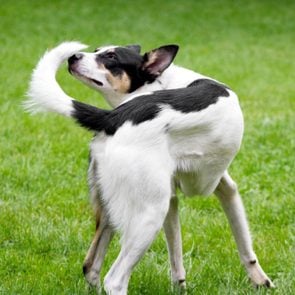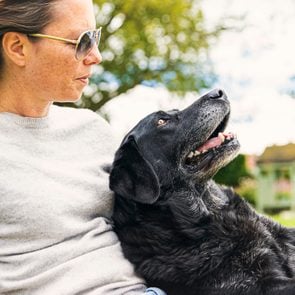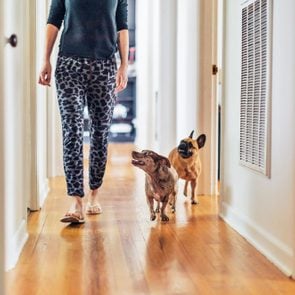12 Ways You’re Annoying a Dog Without Realizing It
Updated: Apr. 18, 2024
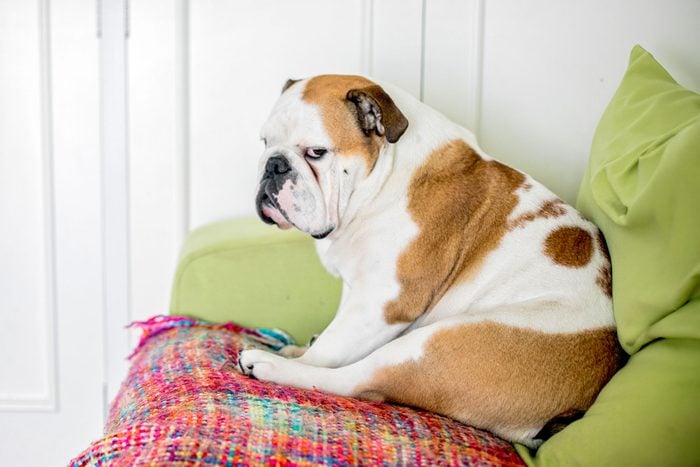
You may think you’re the perfect pet owner … but are you actually getting on your dog’s nerves? Here’s how you’re probably annoying your dog and what to do instead.
You come home from a long day of work, exhausted but thrilled to see your dog wagging his tail and looking up at you with big, expectant eyes. But when you drop to your knees and give your dog a big squeeze, he can’t wait to get away from you. What just happened? If it seems like you’re annoying your dog, that’s because you are!
I have been a veterinarian for nearly 15 years, so I deeply understand dogs and dog behavior, but even I have made the mistake of going in for the hug. Hey, I’m only human! The thing is, while we all want to shower our dogs with love and affection, our version of that may not match up with theirs.
While I’m well versed in this topic, I also spoke to fellow veterinarian Karen Todd-Jenkins, VMD, who has more than 30 years of experience, to get her perspective. Together, we will tell you exactly how you’re accidentally annoying a dog—yours or someone else’s—and provide alternate suggestions that will make them a lot happier.
Get Reader’s Digest’s Read Up newsletter for more pets, cleaning, humor, travel, tech and fun facts all week long.
About the experts
|
You stare at them
It’s not your imagination: Your dog stares at you all the time. It helps him learn your habits and quirks, promotes bonding and even communicates his needs, such as wanting food or needing to go outside. So it’s OK to stare back, right? Nope! A hard stare can annoy a dog, at best, and make it feel threatened, at worst. “Staring is confrontational for dogs and can be misinterpreted as a sign of aggression,” says Dr. Todd-Jenkins.
While it’s OK to briefly return a stare if your dog approaches you and looks into your eyes, don’t do it for more than a few seconds. Also make sure it’s a soft, loving gaze. In fact, this type of interaction is a good thing, prompting the release of oxytocin in both of you, which triggers warm and fuzzy feelings and ultimately strengthens your bond, according to a study published in Science. Whatever you do, though, “do not turn the gaze into a staring contest,” says Dr. Todd-Jenkins. Even if you don’t hold your dog’s gaze for long, you can also show your affection by briefly petting them.
You hug them
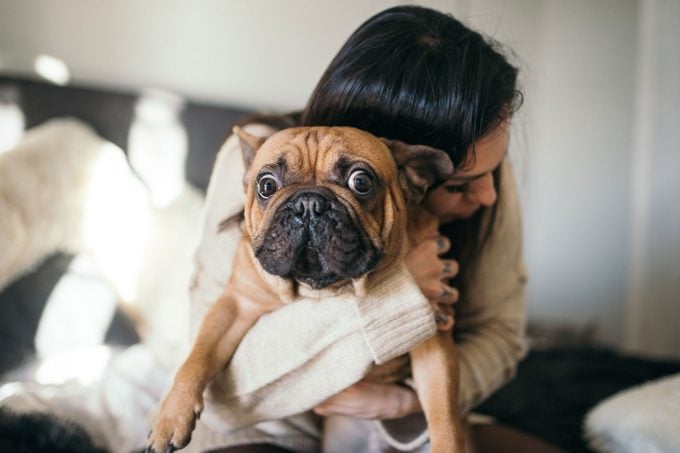
Yes, we hug our human friends and family, but I’m sorry to say that dogs generally don’t love this kind of love. Some dogs don’t mind a brief hug, but for others, “a hug can feel like being restrained, which can have negative connotations,” says Dr. Todd-Jenkins. The key here is to read your dog’s body language. If your pup rushes into your arms, that short hug is OK, but let go immediately if your dog starts wriggling or otherwise seems like he wants to be released. You also shouldn’t pursue a hug if your dog hasn’t initiated one, adds Dr. Todd Jenkins, since it could seem like you’re chasing him, which can annoy or agitate him.
You tease them with toys
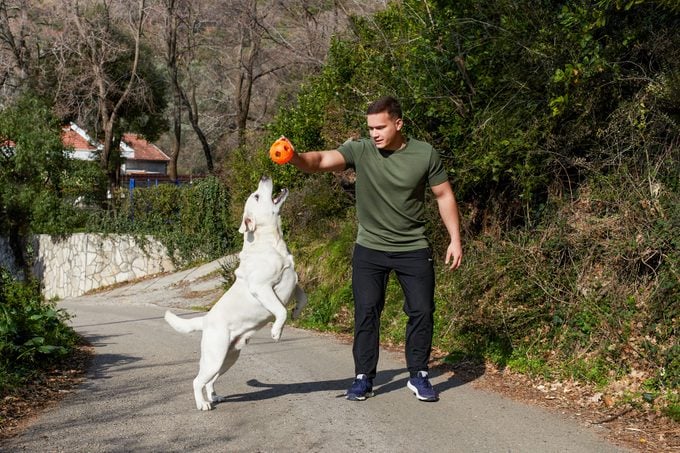
Have you ever done a fake throw of a Frisbee or ball with your dog? This sort of teasing may be funny to you, but it’s annoying to a dog. Why? Because dogs don’t think like us. They don’t understand that teasing and playing pranks can be fun and harmless. Your dog just wants to enjoy playtime with you, which, in their eyes, means that you throw them the ball so they can fetch it. Period. If you tease a dog during playtime, he may not trust you as much, which will weaken your bond.
Rather than teasing your dog, throw the ball or Frisbee whenever you make the throwing motion. If you offer your dog a toy during playtime, let him have it instead of snatching it away as he reaches for it. (Of course, this is different than a good-natured, mutually enjoyable game of tug-of-war.) By not teasing, your dog will continue to trust you, just like he trusts you to feed him when he’s hungry, let him outside to go the bathroom and take care of him when he’s injured or sick.
You talk too much
Dogs make great listening partners. When I was a kid, I would spend many nights sitting next to my 85-pound Lab mix and talking about whatever came to mind. He could have been asleep, but I imagined he was listening to and hanging on my every word. In reality, dogs understand very few of the words we say. If you talk to your dog in a normal tone of voice and launch into a lecture about why he shouldn’t do a particular behavior, like jumping up to greet someone, he simply won’t get it. And he’ll be confused and annoyed, especially if you’re clearly annoyed. While your dog will appreciate that you’re not yelling at him, he’d rather not hear you drone on, saying a bunch of words he just doesn’t understand.
Instead, be brief and use words that you know your dog understands, such as “sit,” stay” or “down.” Also, train your dog to learn and follow basic hand signals.
You talk too loudly
Talking loudly isn’t easy on anybody’s ears, and our dogs don’t like it any more than we do. To our dogs, this sounds like loud, annoying barking, not actual words. “Most dogs have a relatively limited vocabulary,” explains Dr. Todd-Jenkins. “They’re probably not understanding your words and have no idea why you’re [doing this].” And annoying can turn scary if you yell at your dog. In this case, says Dr. Todd-Jenkins, “your dog is reacting, possibly in fear, to your nonverbal cues, like your tone of voice, body posture and gestures.” In that case, your dog might cower or hide under the bed.
In general, remember that your dog’s ears are sensitive, so take it down a notch. Yes, even if you’re just having a good time. And if you are yelling at your dog, stop—you won’t get the result you’re looking for. “A better way to communicate what you want is to reward good behavior when it happens,” says Dr. Todd-Jenkins. “That way, the dog has a reason to exhibit the good behavior again.”
You’re inconsistent with routines
Dogs are happiest when they have predictable daily routines. They like knowing when to eat, play, sleep and greet you at the door. Inconsistent routines don’t allow your dog to know what’s happening when, and while your dog won’t necessarily give you the side eye to show he’s annoyed, he might start behaving badly. In fact, a study published in 2021 in Applied Animal Behaviour Science found that changes in routine were related to dogs chewing on objects. Or if your dog has no idea when you’re going to take him outside, he might start having accidents in the house.
The bottom line, says Dr. Todd-Jenkins, is that “life can be stressful for your pets when their schedules are inconsistent or unpredictable.” Instead, establish and maintain a daily schedule that works for you and your dog. With more predictability, your dog won’t act out quite as much.
You change the rules
Do you let your dog lounge on the couch on a regular day but forbid this behavior when you have guests over? Not a good idea. Changing the rules is annoying to a dog because you are being unclear about how he should behave in different situations. In the moment, your dog will probably look at you quizzically, with his head cocked to the side, waiting for you to give him clear direction on what to do. If you don’t, he might leave the room or go to his bed, deciding it’s not worth the trouble to figure out why you changed the rules.
As with routines, keep your rules consistent, no matter the situation, so your dog can feel confident about how to behave. In a multiperson household, ensure that every household member knows and enforces the rules for your dog. For example, if you have a rule that your dog can’t eat table scraps, make sure no one sneaks a morsel of food to your dog at mealtime.
You leave your dog alone for too long
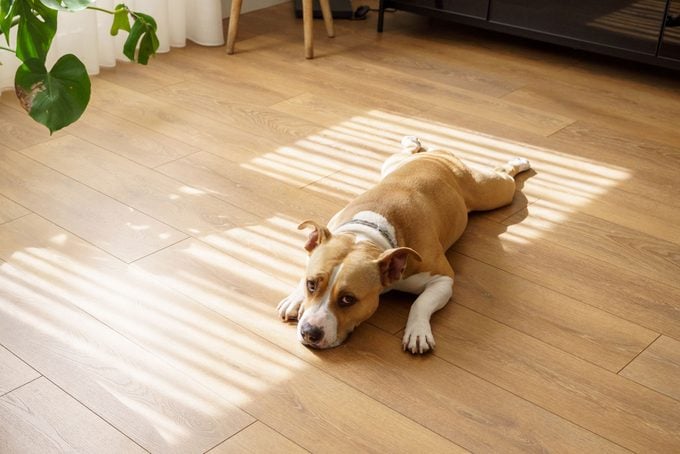
If you work outside the home, it’s hard not to leave your dog alone for a long time. Dogs are social creatures, so spending hours alone can be boring and annoying … which may lead to destructive behavior to pass the time. As a result, you may come home to chewed-up couch cushions or pee on your carpet. Trust me, they’re not happy about this either!
How can you work around this? Consider hiring a dog walker to keep your dog company during the day. Independent enrichment activities, such as food-puzzle toys, can also keep your dog happily entertained until you come home.
You interrupt your dog’s sleep
Just like we can feel annoyed or disgruntled when someone wakes us up from a sound sleep, our dogs don’t appreciate having their sleep interrupted either! If you wake up a dog suddenly, he will be disoriented and confused, wondering what the heck just happened. He will also be grouchy and probably not in the mood to hang out with you, at least until he’s fully awake.
But this is more than mere annoyance—ample sleep is a serious doggy need. Those zzzz’s provide rest and recovery from vigorous play or exercise, gives their brain time to process the day’s events and helps keep their immune system in good working order. For that reason, dogs sleep a lot: Puppies need about 18 to 20 hours of sleep per day to support healthy growth and development, while adult dogs generally do well on about 12 hours of sleep per day.
The bottom line: If your dog is sleeping and enjoying a good dream, let them sleep and wake up naturally.
You rush through your dog’s walks
“Dogs explore their world largely through scent,” says Dr. Todd-Jenkins. “Being outside allows them to experience and engage with their environment more than they would if they weren’t allowed outside of the house.” Plus, after a day of being cooped up, they’re bursting with energy and ready for both socializing with other dogs and spending quality time with you.
How could they not be annoyed if you’re rushing them through the best part of their day? That blade of grass tells them a whole story, not just about what’s happening now but also about what happened in the past. Stretching their legs feels so good. And they get to hang with their favorite human. Rather than rush, move at your dog’s pace and let him sniff and explore to his heart’s content. Schedule this time into your daily schedule so you don’t skimp on it.
You dress up your dog
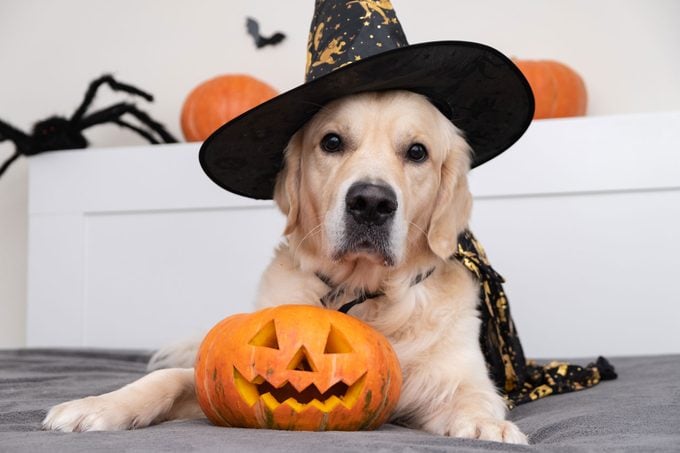
“I can’t say I’ve ever met a dog that looks forward to dressing up—most dogs I’ve encountered just tolerate it,” says Dr. Todd-Jenkins. Although playing dress-up with your dog may give you some Instagram-worthy pictures, don’t be surprised if your dog is annoyed the whole time, fidgeting and trying to get out of the outfit however they can. (Think: tugging at it, rolling on the floor, etc.)
If you can’t resist the lure of the doggy outfit, “give your dog time to get used to the idea of dressing up,” suggests Dr. Todd-Jenkins. First, show your dog the outfit and let him sniff it; then give him a treat. Next, “put the outfit on your dog for a few seconds and take it right off, followed with another treat. Over time, keep the outfit on for longer periods. Ensure the outfit doesn’t hinder movement, breathing, hearing and elimination.”
If your dog is scared of the outfit or simply refuses, respect your dog’s wishes and find another way to take a cute picture, Dr. Todd-Jenkins advises.
You wear strong fragrances
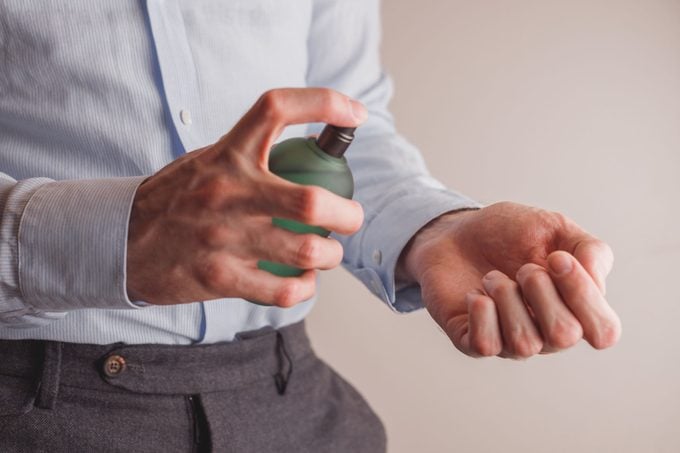
Dogs have hundreds of millions of scent receptors in their noses, so their sense of smell is far more robust than ours. With such sensitive noses, dogs can be annoyed by fragrances that don’t bother us. For example, wearing a small spritz of perfume or cologne could be overwhelming to your dog and even trigger an allergic reaction or tummy upset. And here’s an interesting dog fact: Wearing a strong fragrance hides your natural scent, which your dog uses to recognize you.
If you’re wearing perfume or cologne around your dog, he may distance himself from you to avoid the scent. To avoid offending your dog’s nose or simply confusing him, try not to wear fragrances when you’re spending time together at home.
Why trust us
At Reader’s Digest, we’re committed to producing high-quality content by writers with expertise and experience in their field in consultation with relevant, qualified experts. For this piece on the ways you may be annoying a dog, JoAnna Pendergrass, DVM, tapped her experience as a veterinarian and journalist covering pets, and then Wailani Sung, DVM, DACVB, PhD, a veterinarian specializing in behavioral medicine and the co-author of From Fearful to Fear Free: A Positive Program to Free Your Dog from Anxiety, Fears and Phobias, gave it a rigorous review to ensure that all information is accurate and offers the best possible advice to readers. We verify all facts and data, back them with credible sourcing and revisit them over time to ensure they remain accurate and up to date. Read more about our team, our contributors and our editorial policies.
Sources:
- Karen Todd-Jenkins, VMD, veterinarian and the technical director of the Shepherd Agency; email interview, April 3, 2024
- Physiology and Behavior: “Artificially elevated oxytocin concentrations in pet dogs are associated with higher proximity-maintenance and gazing towards the owners”
- American Veterinary Medical Association: “Human-animal interaction and the human-animal bond”
- Animals (Basel): “Canine olfaction: physiology, behavior, and possibilities for practical applications”
- Applied Animal Behaviour Science: “Chewing behaviour in dogs: A survey-based exploratory study”


